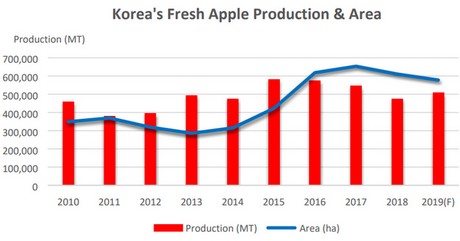
South Korean apple production projected to increas
12 December 2019 - Media Release - Fresh Plaza
In marketing year 2019/20 (July – June), Korea’s fresh apple production is projected to increase seven percent to 508,000 tons, mainly due to favorable weather during the flowering and fruit growing seasons. Although total apple planted area has decreased gradually in recent years, planted area in Gangwondo province is increasing as a warming trend in Korea pushes apple production into colder and higher elevation regions.
Although the total area planted is expected to slightly decrease from 33,234 Ha in MY 2018/19 to 32,954 hectares this year, fresh apple production will increase because of expected eight percent higher yields (more fruit per tree) helped by ample rain during the fruit growing period (May – August).

Production of the late maturing “Fuji” apple, the main apple variety in Korea, is forecast to increase by seven percent from the previous marketing year, driving overall production growth.
Click here for the full report.